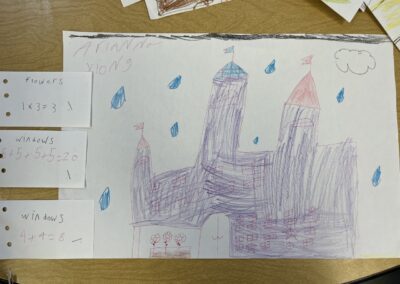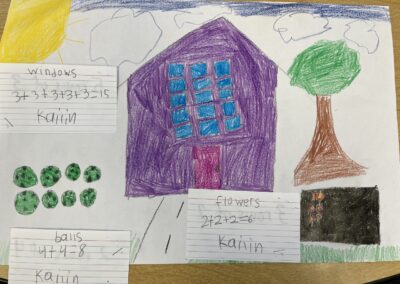Building an Array of Houses
In this lesson, the classroom will create a neighborhood of houses. In order to visualize math concepts, students will practice using arrays and their corresponding repeated addition equations to create a house displaying at least three arrays.
Materials
- large sheets of white and colored construction paper
- Sticky notes
- Markers
- Crayons
- Colored pencils
- Scissors
- Glue/ Tape/ Stapler
- index cards
- stickers
Set Up
Set up a material table with supplies in baskets or containers for students.
Student’s Job
Day 1
T- Your job is to create a house for our classroom neighborhood. You may use the materials provided to create a 2D house (lays flat on paper) that displays at least three arrays and their repeated addition equations.
Examples:
- In the yard, you could draw an array of flowers inside a flower bed.
3 rows of 4 flowers 4+4+4=12 - The windows on your house could make an array.
3 rows of 3 3+3+3=9 - You might put cars in the driveway in 2 rows of 2. The repeated addition equation would be 2+2=4
Steps:
- T- To get started, let’s try to find some arrays in our classroom. Look around the room and see if you can find any real life examples.
S- The Months of the Day chart is an array. It has 6 rows of 2. 2+2+2+2+2+2=12 T- Now, I’ll describe an array I see and you have to find it. I spy an array with 4 columns of 3. Where is it? (Play I Spy Game) Try this game with your partner. - T- Now, let’s think about items you might have inside of your home that are arrays.
S- A cupcake pan or a six pack of soda! T- What other real world examples can we think of? Turn and talk to your partner.
T- Great! - T- Now, think about arrays in your neighborhood. Where might we find some arrays outside of a home, on the home, or in the street? Brainstorm some examples with a partner and we will share them.
- T- Your job is to create a house for our classroom neighborhood. You may use the materials provided to create a 2D house ( lays flat on paper) that displays at least three different arrays and their corresponding repeated addition equations.
- T- I have written some array descriptions on index cards (ex. 3 rows of 2) for those who want them. You can choose to use the cards I made or you can create your own array descriptions. If you use the cards I made, you will randomly select them from the deck.
- T- On the table, I have sticky notes, stickers, crayons, colored pencils, large white pieces of paper, …etc. You may take what you need and return to your seat to start drawing your house. (Teacher can model how to draw a simple house out of a square and triangle to help frustrated students).
- T- When you have drawn your house and arrays, you will write your repeated addition equations on the index cards. Write the name of the object in the array you are describing. We will staple the index cards to your completed work. ( ex. Flowers, 2 rows of 3, 3 + 3 = 6)
Day 2
- T- Today, we are going to play an array game outside in the school yard. I have pieces of paper that contain array descriptions like 2 rows of 3 or 4 columns of 5. After showing you the description, you and your classmates will have to make the array with your bodies! Let’s play Human Array!
- T- Now, we are going to take all of our houses and hang them up to make a neighborhood. Once we are done hanging up your papers, I want you to draw 3 arrays you see in the class neighborhood that are different from the ones you already drew and label them with a repeated addition equation.
S- (Get a white sheet of paper and draw 3 different arrays they see in the neighborhood)
Further Challenges:
Introduction- Search for videos on the internet and/or quizlet flashcards to show students more examples of arrays in real life.
Whole group activity for learners who need a more scaffolded approach- Start by identifying and labeling all arrays found in the classroom with students. Teacher will model a classroom drawing with the arrays shown.
Homework- Have students bring in pictures or objects as examples of arrays.
Center- Match array cards with their repeated addition equation.
Center – Students take turns drawing arrays and writing down the matching description (2 rows of 3 or 3 columns of 2).
Follow up questions:
- Does your repeated addition equation match your array? How do you know? How many columns are in the array? How many rows?
Do you have an odd or even number of objects in your array? How do you know? - Geometry- Have students draw the houses using at least 4 different 2D shapes and label the shapes.
- Social Studies- Where can you find arrays in the school, community, neighborhood, city, state, and country?
Teacher’s Job
Standards Alignment
Common Core State Standards: Math- 2nd Grade
Component:
Work with equal groups of objects to gain foundations for multiplication.
CCSS.MATH.CONTENT.2.OA.C.4
Use addition to find the total number of objects arranged in rectangular arrays with up to 5 rows and up to 5 columns; write an equation to express the total as a sum of equal addends.
Prepare/ Background Info
Students have been studying foundations of multiplication for several weeks. We have learned about how arrays are formed and how repeated addition relates to arrays.
Students should already know:
Arrays are made of equal groups. Arrays have columns and rows and what is the difference between the two. Repeated addition equations describe arrays. You can also describe an array by stating the amount of rows and columns/ columns and rows. Arrays form a rectangle.
Effective Facilitation
Allow students time to explore and talk with their partners about real life examples of arrays. Spend time asking students to describe their arrays. Read the room and decide if students will need assistance drawing a house. Organize the materials they need and call them up one by one to the supply table. Provide a model for students to follow if they get frustrated.
Play to Notice
Child-Centered
Choice
Challenge
Active
Social Support
Tangible
Familiar and Unexpected
Making Learning Visible
Content Matter to Notice
Columns, rows, arrays, foundations of multiplication, equal groups, repeated addition, real world applications, organization, label
SEL to Notice
Turn and talk with a partner
Engage in discussion about arrays
Participate in “I Spy”
Create and share




0 Comments